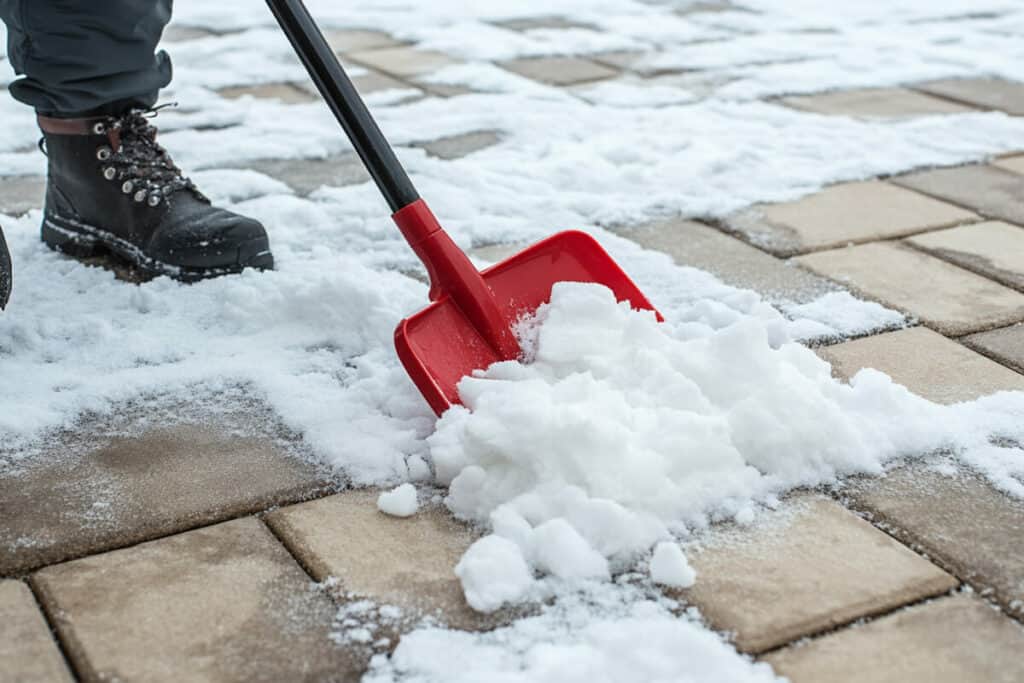When winter comes, your pavement needs special care. Snow, ice, and cold temperatures can damage the surfaces around your home. You might face expensive repairs later if you don’t protect your driveway, paths, and patio. This guide will show you how to keep your paving in good condition during the cold months.
Table of contents:
- Essential steps to keep your paving in good condition during winter
- Winter maintenance tips for specific paving materials
- Winter preparation checklist for paving
Essential steps to keep your paving in good condition during winter
Clear snow and ice safely
Snow and ice can make your paving slippery and increase the risk of accidents. To keep it safe and avoid damaging the surface, use a plastic shovel instead of a metal one. Plastic shovels are less likely to scratch or chip the paving.
If the snow is light and dry, you can use a leaf blower to clear it. However, this method won’t work if the snow is heavy or compacted. When applying de-icing products, avoid using salt, as it can weaken the surface and cause cracks. Instead, choose non-abrasive options like sand or calcium chloride, which are safer for most paving materials.
After removing snow, check for icy patches and apply the de-icing product evenly to improve traction and prevent accidents. Clearing snow promptly stops ice from forming underneath and protects the paving from prolonged exposure to cold and moisture.
Remove dirt, leaves, and debris regularly
During winter, dirt, leaves, and other debris can build up on your paving. If left unattended, decaying leaves can release tannins, which may stain the surface and make it harder to clean later. Regularly sweeping your paving can help prevent these stains and keep the surface looking neat.
Debris can also create a slippery surface, especially when combined with moisture from rain or snow. By keeping the paving clear, you reduce the risk of accidents and prevent moss or algae from growing in damp conditions. Pay extra attention to areas where leaves tend to gather, such as corners or beneath overhanging trees.
Make it a habit to sweep your paving after strong winds or heavy rain. You don’t need any special tools — just a stiff broom or a rake will do the job. The key is consistency, as clearing debris frequently will save you from bigger problems later.
Prevent water accumulation
Water can cause significant damage to your paving during winter, especially if it freezes and expands. This process, known as the freeze/thaw cycle, can lead to cracks in the surface and weaken the structure of your paving. To prevent these issues, it’s important to manage water effectively.
Start by checking your drainage system. Make sure there are no blockages, and that water flows away from the paved areas. If you notice any pooling or stagnant water, address the issue immediately by improving drainage or levelling uneven surfaces.
Inspect the paving regularly for gaps or cracks where water might seep in. Fill these areas before winter sets in to stop water from getting trapped. Small repairs now can prevent larger, costlier issues later. Taking these steps ensures that your paving stays strong and durable throughout the cold months.

Winter maintenance tips for specific paving materials
Different paving materials require specific care to ensure they remain durable and attractive throughout the winter. Here’s how to handle the most common types:
Natural stone paving
Natural stone is porous, which makes it more vulnerable to water damage during the freeze/thaw cycle. Before winter, it’s essential to seal the surface with a high-quality stone sealant. This protective layer helps prevent water from seeping into the material and causing cracks.
When cleaning natural stone, avoid harsh chemicals or abrasive tools, as these can erode the surface. Stick to mild cleaning solutions and soft brushes. If snow or ice accumulates, use a plastic shovel or a non-abrasive de-icing product like sand or calcium chloride. Metal tools and salt can damage the surface, so they should be avoided.
Porcelain paving
Porcelain paving is naturally resistant to water absorption and frost, making it a low-maintenance option for winter. Unlike natural stone, it doesn’t require sealing. So focus on keeping the surface clean by sweeping regularly and removing any debris that could become slippery in wet or icy conditions.
When clearing snow, a plastic shovel or a soft broom is sufficient. Avoid using heavy equipment that could chip or crack the tiles.
Concrete and brick paving
Concrete and brick paving are durable but still need attention to avoid damage during winter. Inspect for cracks or gaps in the surface and repair them before the cold weather sets in. Small cracks can expand during the freeze/thaw cycle, leading to more significant issues.
Keep these surfaces clear of snow and debris to prevent moisture buildup. If moss or algae appear, treat these spots promptly with a cleaning solution suited for concrete or brick.
Winter preparation checklist for paving
We’ve covered everything you need to know about maintaining your paving during winter. However, to ensure you don’t miss anything and get it right, here’s a simple checklist to help you prepare effectively.
| Step | What to do | Reasons |
| Seal Your Paving in Autumn | Apply a suitable sealant to protect porous materials like natural stone from water absorption. | Prevents cracks and damage caused by the freeze/thaw cycle during winter. |
| Inspect Drainage Systems | Check for blockages and ensure water flows away from the paved area. Repair any issues promptly. | Avoids water pooling, which can lead to long-term structural damage and icy hazards. |
| Repair Mortar Joints | Fill in any gaps or cracks in the paving or between slabs with a durable mortar or filler. | Prevents water from seeping in and freezing, which can cause further cracking and instability. |
| Move Pots and Furniture | Relocate plant pots, garden furniture, and other heavy items periodically throughout the season. | Prevents staining and debris buildup underneath, which can be difficult to clean come spring. |
| Sweep Regularly Before Winter | Remove leaves and debris from the surface, especially after autumn storms or strong winds. | Avoids tannin stains from decaying leaves and prevents moss and algae from forming in damp areas. |
Taking these steps before winter begins can save you time and money on repairs later. Regular maintenance now will also make it easier to keep your paving clean and safe throughout the colder months. By following this checklist, you’ll ensure your paving remains durable and ready for use when spring returns.

